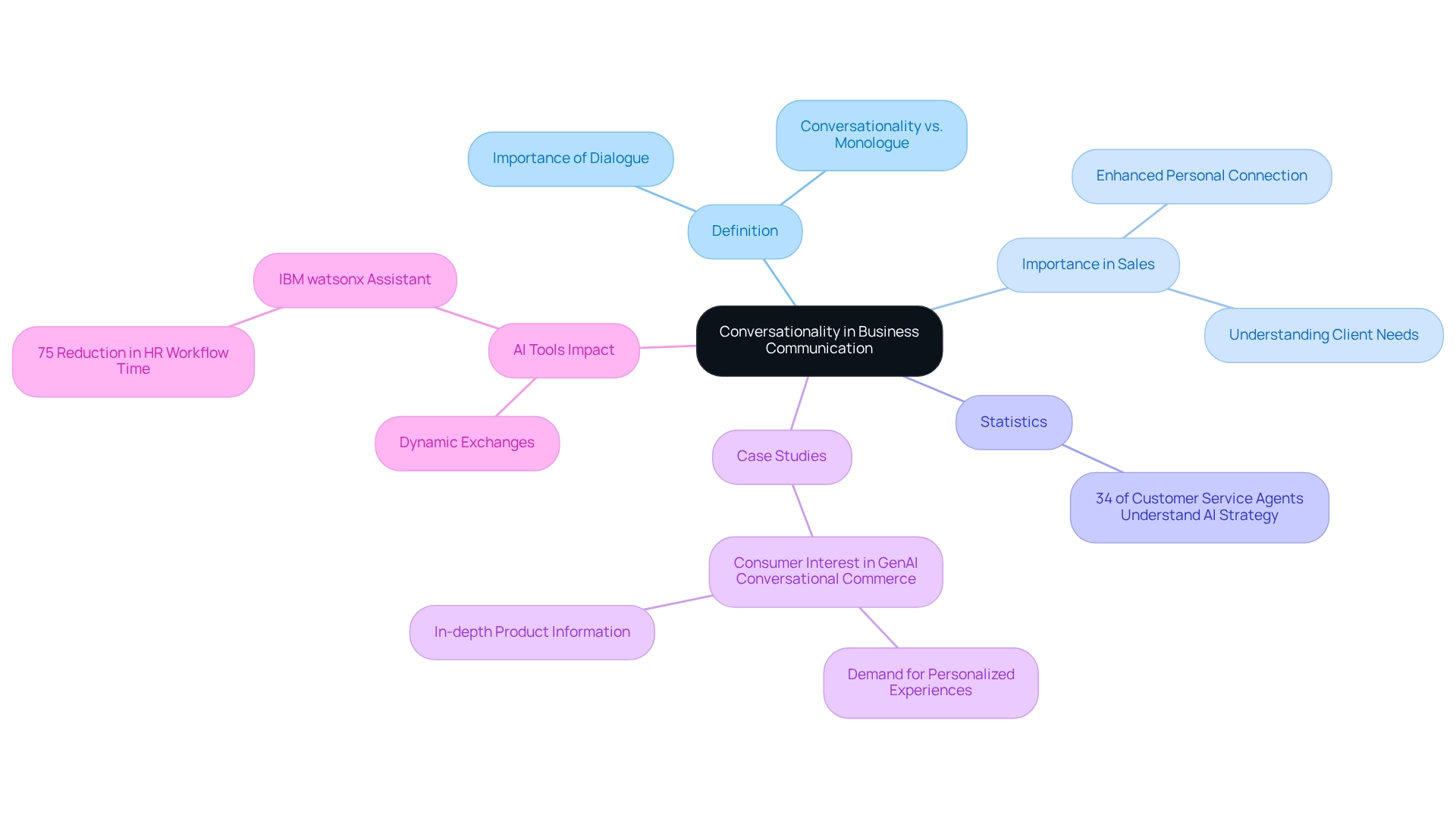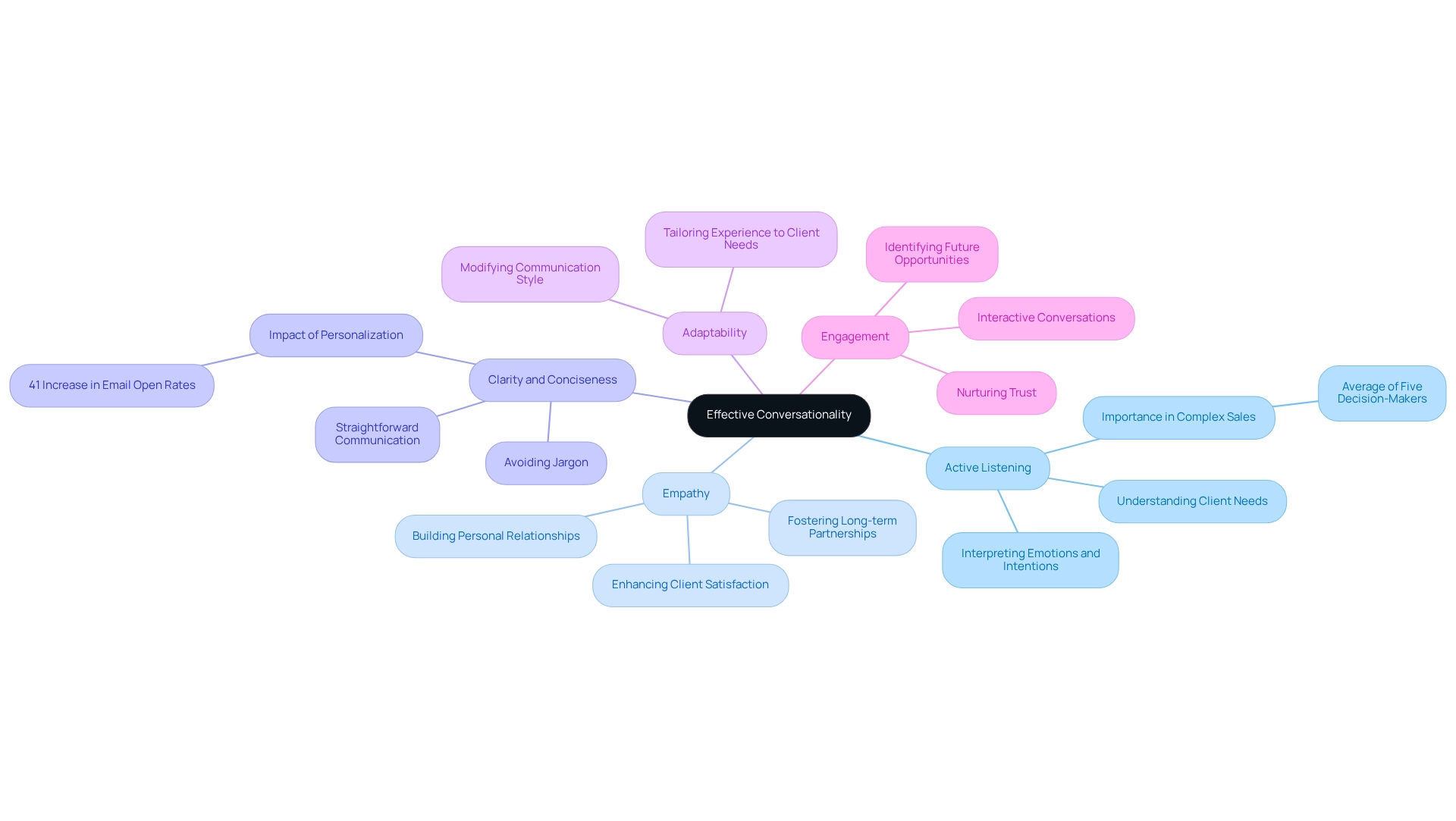
Understanding Conversationality: Key to Sales Success
GeneralKey Highlights:
- Conversationality prioritises dialogue over monologue in business interactions, fostering meaningful exchanges.
- Only 34% of customer service agents understand their department’s AI strategy, indicating a knowledge gap in leveraging conversational AI.
- Conversational selling techniques lead to higher conversion rates and improved client loyalty.
- Key traits of effective conversationality include active listening, empathy, clarity, adaptability, and engagement.
- Companies using chatbots for real-time client interactions saw a 30% increase in conversion rates.
- A software company employing personalised dialogues instead of scripted pitches achieved a 20% rise in customer retention.
- The use of voice AI solutions can enhance conversational quality and drive business benefits.
Introduction
In a world where customer expectations are continuously evolving, the art of conversation has emerged as a critical component of successful business communication. Conversationality transcends traditional sales tactics, fostering genuine dialogue that not only engages clients but also builds lasting relationships.
As organisations increasingly turn to conversational AI and innovative communication strategies, the ability to connect with customers on a personal level becomes paramount. This article delves into the essence of conversationality in business, exploring its pivotal role in enhancing sales success and identifying the key characteristics that define effective interactions.
Through compelling examples and insights, it highlights how embracing a conversational approach can lead to improved outcomes and stronger customer loyalty.
Define Conversationality in Business Communication
The quality and style of exchanges that prioritize dialogue over monologue embody conversationality in business interactions. It underscores the importance of conversationality in interactive dialogue, where both parties engage in a meaningful exchange of ideas. This approach starkly contrasts with conventional methods of information delivery, which often rely on one-sided presentations or scripted dialogues. In sales, conversationality enhances the personal connexion between sales representatives and clients, facilitating a deeper understanding of client needs and preferences.
Current statistics reveal a concerning reality: only 34% of customer service agents comprehend their department’s AI strategy. This highlights a significant gap in understanding how conversational AI can enhance communication. Such a lack of comprehension can hinder the effectiveness of conversational AI tools, which are designed to promote dynamic exchanges that respond to real-time feedback. By leveraging these tools, businesses can significantly enhance their interactions, rendering them more engaging and responsive.
For instance, a recent case study on consumer interest in GenAI-powered conversational commerce reveals a growing demand for interactive and personalised shopping experiences. This showcases how AI technologies can facilitate deeper connexions with consumers. This shift highlights the significance of conversationality across various business functions, not just in transactions, as it improves communication effectiveness and results in better outcomes. Furthermore, as highlighted by IBM, the use of AI-powered tools can substantially reduce the time employees spend on routine workflows, underscoring the efficiency gains that conversational AI can deliver to business processes.

Explore the Role of Conversationality in Sales Success
Conversational skills are essential for achieving success in transactions, as they cultivate an environment where clients feel valued and understood. When sales representatives engage in authentic dialogues, they establish rapport and trust—critical components for closing deals. This approach not only uncovers client pain points but also facilitates the customisation of solutions to address specific needs.
Research indicates that companies employing conversational selling techniques experience significantly higher conversion rates and enhanced client loyalty. For instance, teams that prioritise genuine interactions often report improved revenue outcomes, as they can respond to inquiries more effectively and nurture lasting relationships.
Moreover, Agentics’ voice AI solutions can substantially elevate this conversational quality by delivering personalised interactions that resonate with customers, ensuring they feel acknowledged and appreciated. The ability to inspire oneself and others is closely linked to commercial success, highlighting the importance of conversationality in approach.
As Doug Warner, Chief Innovation Officer at AMP Up1 Hospitality Management, observes, in a competitive landscape where competitors are merely a click away, effective communication can be a transformative factor. A case study titled ‘Competing with Oneself for Improvement’ illustrates that professionals who focus on personal development rather than comparisons with peers achieve superior results.
By adopting conversationality and utilising Agentics’ innovative voice AI solutions, businesses can significantly enhance client interactions and elevate their revenue performance to unprecedented levels.
Identify Key Characteristics of Effective Conversationality
Effective conversationality in sales is defined by several essential traits that drive success:
- Active Listening: Sales representatives must engage in active listening to fully understand client needs. This goes beyond merely hearing words; it involves interpreting emotions and intentions. Given that there are an average of five decision-makers involved in every sales process today, this skill is crucial.
- Empathy: Demonstrating empathy allows salespeople to forge personal relationships with clients, making them feel recognised and appreciated. This emotional engagement significantly enhances client satisfaction and loyalty, fostering long-term partnerships.
- Clarity and Conciseness: Communication should be straightforward and to the point, steering clear of jargon that may perplex clients. Clear messaging is vital for effective engagement and understanding. Notably, personalisation in email follow-ups can positively influence open rates by as much as 41%, underscoring the importance of customised interaction.
- Adaptability: Successful conversationalists modify their communication style based on client feedback, ensuring a tailored experience that resonates with individual needs.
- Engagement: Keeping conversations interactive encourages customers to share more about their requirements, leading to better solutions. For instance, case studies demonstrate that active listening not only aids in immediate transactions but also nurtures the trust essential for enduring relationships. By consistently interacting with clients and comprehending their goals, representatives can identify upcoming prospects and maintain lasting loyalty.
As Mary Flaherty, Vice President of Research and Thought Leadership, states, “By utilising these insights and concentrating on the practises of Top Performers, both sellers and leaders can achieve significant enhancements in their outcomes.”
These traits are essential for fostering meaningful engagements that promote success in revenue generation through improved conversationality. They enable sales experts to connect profoundly with their clients and respond efficiently to their evolving requirements.

Examine Examples of Conversationality Enhancing Sales Outcomes
Numerous companies have successfully utilised conversationality to elevate their sales outcomes. Consider a leading e-commerce site that adopted chatbots, enabling real-time interactions with clients and resulting in an impressive 30% rise in conversion rates. This innovative approach allowed clients to ask questions and receive prompt responses, creating a seamless and engaging shopping experience.
Similarly, a software company embraced a conversational sales strategy, equipping its sales team to engage prospects through personalised dialogues rather than relying on scripted pitches. This strategic shift led to a remarkable 20% increase in customer retention rates, as clients felt a stronger connexion to the brand.
Furthermore, leveraging voice AI solutions, such as those offered by Agentics, can further enhance these conversational strategies by providing real-time insights and facilitating more dynamic interactions. These instances underscore the transformative potential of conversationality in sales strategies, showcasing its ability to drive significant business benefits.
In conclusion, adopting conversational approaches not only fosters stronger client relationships but also drives tangible results. Companies looking to improve their sales outcomes should consider integrating these strategies into their operations.
Conclusion
Embracing conversationality in business communication transcends mere trend; it represents a fundamental shift that significantly enhances customer engagement and drives sales success. By prioritising two-way dialogues over traditional one-sided interactions, organisations can cultivate deeper connexions with their clients. This approach, characterised by active listening, empathy, clarity, adaptability, and engagement, empowers sales representatives to effectively understand and address customer needs.
The evidence is compelling: companies that adopt conversational selling techniques witness higher conversion rates and improved customer loyalty. Real-world examples underscore the tangible benefits of integrating conversationality into sales strategies, from increased conversion rates through chatbots to personalised interactions that bolster customer retention. These successes illuminate the critical role of genuine dialogue in building trust and rapport, essential components for closing deals and fostering long-term relationships.
In a competitive landscape where customer expectations continually evolve, the ability to engage in meaningful conversations is more crucial than ever. By leveraging conversational AI and innovative communication techniques, businesses can not only enhance their interactions but also forge lasting loyalty among their customers. Ultimately, the future of successful business communication lies in the art of conversation, making it imperative for organisations to embrace this approach for sustained growth and success.
Frequently Asked Questions
What is conversationality in business communication?
Conversationality in business communication refers to the quality and style of exchanges that prioritise dialogue over monologue, emphasising meaningful exchanges of ideas between parties.
How does conversationality differ from traditional communication methods?
Conversationality contrasts with conventional methods that often rely on one-sided presentations or scripted dialogues, promoting interactive dialogue instead.
What role does conversationality play in sales?
In sales, conversationality enhances the personal connexion between sales representatives and clients, facilitating a deeper understanding of client needs and preferences.
What is the current understanding of AI strategies among customer service agents?
Only 34% of customer service agents comprehend their department’s AI strategy, indicating a significant gap in understanding how conversational AI can enhance communication.
How can conversational AI tools improve business interactions?
Conversational AI tools can promote dynamic exchanges that respond to real-time feedback, making interactions more engaging and responsive.
What recent trends have been observed in consumer interest regarding AI in commerce?
A recent case study indicates a growing demand for interactive and personalised shopping experiences powered by GenAI, showcasing how AI can facilitate deeper connexions with consumers.
Why is conversationality significant across various business functions?
Conversationality improves communication effectiveness and leads to better outcomes, impacting not just transactions but all areas of business.
What efficiency gains can AI-powered tools deliver to business processes?
AI-powered tools can substantially reduce the time employees spend on routine workflows, enhancing overall efficiency in business operations.
Enjoyed this post? Share it with your network!
10 Best AI Sales Tools to Boost Your Team’s Performance

Discover the top 10 best AI sales tools to enhance team performance and drive revenue growth.
Mastering Test Call Numbers: A Step-by-Step Guide for Sales Directors

Elevate your communication with our guide on mastering test call numbers for sales success.
7 Ways Automated Outbound Calls Boost Sales Performance

Discover how automated outbound calls enhance sales performance and streamline communication.
